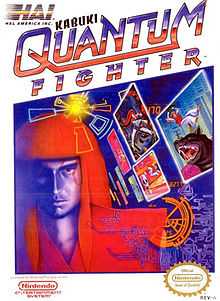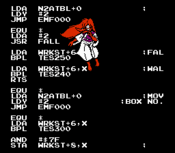Kabuki Quantum Fighter
| Kabuki Quantum Fighter | |
|---|---|
 North American cover art | |
| Developer(s) | Human Entertainment[1] |
| Publisher(s) | |
| Designer(s) | Hiroyuki Itoh |
| Programmer(s) | Hiroshi Haruna Takashi Arai |
| Composer(s) | Masaki Hashimoto Takahiro Wakuta |
| Platform(s) | NES[1] |
| Release date(s) | |
| Genre(s) | 2D action platformer[1] |
| Mode(s) | Single-player |
| Distribution | Cartridge |
Kabuki Quantum Fighter (地獄極楽丸 Jigoku Gokuraku Maru) is a 2D action platformer video game developed by Human Entertainment and published by the defunct American publishing arm of HAL Laboratory for the Nintendo Entertainment System. It was originally released on December 21, 1990 in Japan and was released in 1991 for the North American and European markets.
Synopsis and plot

Players adopt the persona of 25-year-old Colonel Scott O'Connor, a military agent who has transferred his brain into raw binary code in order to combat a rogue program in the main defense computer. When O'Connor enters the system, his body forms the self-image of his ancestor, who was a Kabuki actor.
In the year 2056, a virus has appeared in the main defense computer of the planet Earth. The origin and nature of the virus is unknown. Scott O'Connor volunteers to undergo an experimental transfer technology that converts his brain into raw binary code. He takes on the image of a Kabuki dancer, since the computer recognizes his great-grandfather as one. The virus in the virtual world takes on properties of an actual virus-it leaves behind debris, mutant creatures, and parasite environments of a biological nature. At the final level, it is revealed that the virus is of alien origin, having been picked up by a lost Hyperion probe launched to a neighboring planet. O'Connor stops it before the virus can order the Hyperion to fire its laser weapons and destroy the human population.
Despite the futuristic spin to the plot, the global defense computer runs on a simple 6502 central processing unit; a common feature among console video games and personal computers during the 1980s. One of the programmers had recently learned the programming language for 6502 and wanted to show it off while assembling this game.
Gameplay
The field is generally side-scrolling, with a single room with a boss at the end of each level.
Players use their long hair and chip-based weaponry to attack enemies inside the computer.
Upon beating the game, a sound test menu is active with a two-frame animation of Scott under his Kabuki guise, bowing. He also says to watch for him in his next game, which never came to be.
| Reception | ||||||||||||||||||||||||||||||||||||||||||||||||||||||||||||||
|---|---|---|---|---|---|---|---|---|---|---|---|---|---|---|---|---|---|---|---|---|---|---|---|---|---|---|---|---|---|---|---|---|---|---|---|---|---|---|---|---|---|---|---|---|---|---|---|---|---|---|---|---|---|---|---|---|---|---|---|---|---|---|
| ||||||||||||||||||||||||||||||||||||||||||||||||||||||||||||||